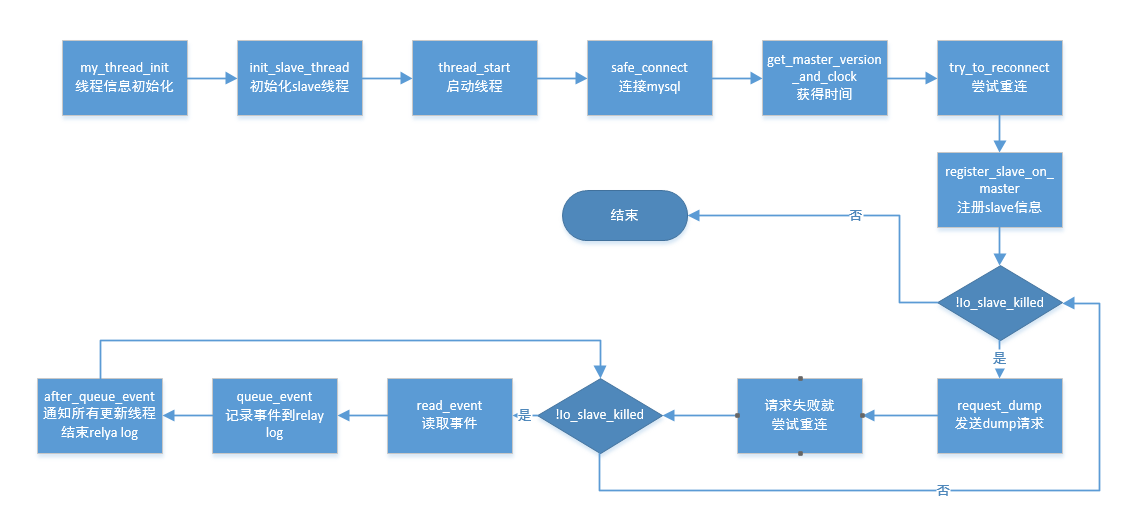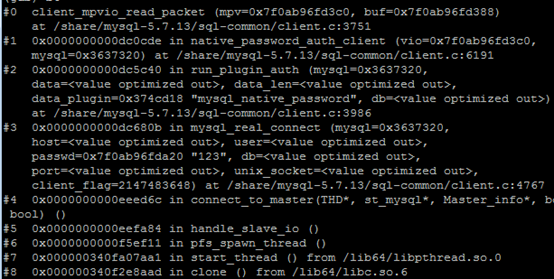slave IO流程之一:mysql登陆过程(mysql_real_connect)
最近看了slave IO的源码,发现slave IO的写relay log貌似是单线程单连接的,这让我有点小失望。
slave IO的主函数是handle_slave_io,处理流程如下:

图1 handle_slave_io处理流程
我们这次主要要完成safe_connect以及try_to_reconnet用到的核心函数 mysql_real_connect流程的探索。
一、mysql_real_connect流程
在这之前我们需要弄明白连接mysql需要那几步操作,参考自官网的文档(http://dev.mysql.com/doc/internals/en/plain-handshake.html),据说连接时需要以下操作:

图2 mysql_real_connect操作流程
1.建立与mysql的连接
对于需要连接的建立一个监听端口,然后建立与链表中的所有服务端建立连接,并绑定到监听端口

1 if (!net->vio && 2 (!mysql->options.protocol || 3 mysql->options.protocol == MYSQL_PROTOCOL_SOCKET) && 4 (unix_socket || mysql_unix_port) && 5 (!host || !strcmp(host,LOCAL_HOST))) 6 { 7 my_socket sock= socket(AF_UNIX, SOCK_STREAM, 0); 8 DBUG_PRINT("info", ("Using socket")); 9 if (sock == SOCKET_ERROR) 10 { 11 set_mysql_extended_error(mysql, CR_SOCKET_CREATE_ERROR, 12 unknown_sqlstate, 13 ER(CR_SOCKET_CREATE_ERROR), 14 socket_errno); 15 goto error; 16 } 17 18 net->vio= vio_new(sock, VIO_TYPE_SOCKET, 19 VIO_LOCALHOST | VIO_BUFFERED_READ); 20 if (!net->vio) 21 { 22 DBUG_PRINT("error",("Unknow protocol %d ", mysql->options.protocol)); 23 set_mysql_error(mysql, CR_CONN_UNKNOW_PROTOCOL, unknown_sqlstate); 24 closesocket(sock); 25 goto error; 26 } 27 28 host= LOCAL_HOST; 29 if (!unix_socket) 30 unix_socket= mysql_unix_port; 31 host_info= (char*) ER(CR_LOCALHOST_CONNECTION); 32 DBUG_PRINT("info", ("Using UNIX sock '%s'", unix_socket)); 33 34 memset(&UNIXaddr, 0, sizeof(UNIXaddr)); 35 UNIXaddr.sun_family= AF_UNIX; 36 strmake(UNIXaddr.sun_path, unix_socket, sizeof(UNIXaddr.sun_path)-1); 37 38 if (vio_socket_connect(net->vio, (struct sockaddr *) &UNIXaddr, 39 sizeof(UNIXaddr), get_vio_connect_timeout(mysql))) 40 { 41 DBUG_PRINT("error",("Got error %d on connect to local server", 42 socket_errno)); 43 set_mysql_extended_error(mysql, CR_CONNECTION_ERROR, 44 unknown_sqlstate, 45 ER(CR_CONNECTION_ERROR), 46 unix_socket, socket_errno); 47 vio_delete(net->vio); 48 net->vio= 0; 49 goto error; 50 } 51 mysql->options.protocol=MYSQL_PROTOCOL_SOCKET; 52 }

1 for (t_res= res_lst; t_res; t_res= t_res->ai_next) 2 { 3 DBUG_PRINT("info", ("Create socket, family: %d type: %d proto: %d", 4 t_res->ai_family, t_res->ai_socktype, 5 t_res->ai_protocol)); 6 7 sock= socket(t_res->ai_family, t_res->ai_socktype, t_res->ai_protocol); 8 if (sock == SOCKET_ERROR) 9 { 10 DBUG_PRINT("info", ("Socket created was invalid")); 11 /* Try next address if there is one */ 12 saved_error= socket_errno; 13 continue; 14 } 15 16 if (client_bind_ai_lst) 17 { 18 struct addrinfo* curr_bind_ai= NULL; 19 DBUG_PRINT("info", ("Attempting to bind socket to bind address(es)")); 20 21 /* 22 We'll attempt to bind to each of the addresses returned, until 23 we find one that works. 24 If none works, we'll try the next destination host address 25 (if any) 26 */ 27 curr_bind_ai= client_bind_ai_lst; 28 29 while (curr_bind_ai != NULL) 30 { 31 /* Attempt to bind the socket to the given address */ 32 bind_result= bind(sock, 33 curr_bind_ai->ai_addr, 34 curr_bind_ai->ai_addrlen); 35 if (!bind_result) 36 break; /* Success */ 37 38 DBUG_PRINT("info", ("bind failed, attempting another bind address")); 39 /* Problem with the bind, move to next address if present */ 40 curr_bind_ai= curr_bind_ai->ai_next; 41 } 42 43 if (bind_result) 44 { 45 /* 46 Could not bind to any client-side address with this destination 47 Try the next destination address (if any) 48 */ 49 DBUG_PRINT("info", ("All bind attempts with this address failed")); 50 saved_error= socket_errno; 51 closesocket(sock); 52 continue; 53 } 54 DBUG_PRINT("info", ("Successfully bound client side of socket")); 55 } 56 57 /* Create a new Vio object to abstract the socket. */ 58 if (!net->vio) 59 { 60 if (!(net->vio= vio_new(sock, VIO_TYPE_TCPIP, flags))) 61 { 62 set_mysql_error(mysql, CR_OUT_OF_MEMORY, unknown_sqlstate); 63 closesocket(sock); 64 freeaddrinfo(res_lst); 65 if (client_bind_ai_lst) 66 freeaddrinfo(client_bind_ai_lst); 67 goto error; 68 } 69 } 70 /* Just reinitialize if one is already allocated. */ 71 else if (vio_reset(net->vio, VIO_TYPE_TCPIP, sock, NULL, flags)) 72 { 73 set_mysql_error(mysql, CR_UNKNOWN_ERROR, unknown_sqlstate); 74 closesocket(sock); 75 freeaddrinfo(res_lst); 76 if (client_bind_ai_lst) 77 freeaddrinfo(client_bind_ai_lst); 78 goto error; 79 } 80 81 DBUG_PRINT("info", ("Connect socket")); 82 status= vio_socket_connect(net->vio, t_res->ai_addr, 83 (socklen_t)t_res->ai_addrlen, 84 get_vio_connect_timeout(mysql)); 85 /* 86 Here we rely on vio_socket_connect() to return success only if 87 the connect attempt was really successful. Otherwise we would 88 stop trying another address, believing we were successful. 89 */ 90 if (!status) 91 break; 92 93 /* 94 Save either the socket error status or the error code of 95 the failed vio_connection operation. It is necessary to 96 avoid having it overwritten by later operations. 97 */ 98 saved_error= socket_errno; 99 100 DBUG_PRINT("info", ("No success, try next address.")); 101 }
2.读取初始握手报文

1 if ((pkt_length=cli_safe_read(mysql, NULL)) == packet_error) 2 { 3 if (mysql->net.last_errno == CR_SERVER_LOST) 4 set_mysql_extended_error(mysql, CR_SERVER_LOST, unknown_sqlstate, 5 ER(CR_SERVER_LOST_EXTENDED), 6 "reading initial communication packet", 7 socket_errno); 8 goto error; 9 } 10 pkt_end= (char*)net->read_pos + pkt_length; 11 /* Check if version of protocol matches current one */ 12 mysql->protocol_version= net->read_pos[0]; 13 DBUG_DUMP("packet",(uchar*) net->read_pos,10); 14 DBUG_PRINT("info",("mysql protocol version %d, server=%d", 15 PROTOCOL_VERSION, mysql->protocol_version)); 16 if (mysql->protocol_version != PROTOCOL_VERSION) 17 { 18 set_mysql_extended_error(mysql, CR_VERSION_ERROR, unknown_sqlstate, 19 ER(CR_VERSION_ERROR), mysql->protocol_version, 20 PROTOCOL_VERSION); 21 goto error; 22 } 23 server_version_end= end= strend((char*) net->read_pos+1); 24 mysql->thread_id=uint4korr((uchar*) end + 1); 25 end+=5; 26 /* 27 Scramble is split into two parts because old clients do not understand 28 long scrambles; here goes the first part. 29 */ 30 scramble_data= end; 31 scramble_data_len= AUTH_PLUGIN_DATA_PART_1_LENGTH + 1; 32 scramble_plugin= NULL; 33 end+= scramble_data_len; 34 35 if (pkt_end >= end + 1) 36 mysql->server_capabilities=uint2korr((uchar*) end); 37 if (pkt_end >= end + 18) 38 { 39 /* New protocol with 16 bytes to describe server characteristics */ 40 mysql->server_language=end[2]; 41 mysql->server_status=uint2korr((uchar*) end + 3); 42 mysql->server_capabilities|= uint2korr((uchar*) end + 5) << 16; 43 pkt_scramble_len= end[7]; 44 if (pkt_scramble_len < 0) 45 { 46 set_mysql_error(mysql, CR_MALFORMED_PACKET, 47 unknown_sqlstate); /* purecov: inspected */ 48 goto error; 49 } 50 } 51 end+= 18; 52 53 if (mysql_init_character_set(mysql)) 54 goto error;
3.发送回复握手报文
通过run_plugin_auth发送回复握手报文

1 mpvio.mysql_change_user= data_plugin == 0; 2 mpvio.cached_server_reply.pkt= (uchar*)data; 3 mpvio.cached_server_reply.pkt_len= data_len; 4 mpvio.read_packet= client_mpvio_read_packet; 5 mpvio.write_packet= client_mpvio_write_packet; 6 mpvio.info= client_mpvio_info; 7 mpvio.mysql= mysql; 8 mpvio.packets_read= mpvio.packets_written= 0; 9 mpvio.db= db; 10 mpvio.plugin= auth_plugin; 11 12 MYSQL_TRACE(AUTH_PLUGIN, mysql, (auth_plugin->name)); 13 14 res= auth_plugin->authenticate_user((struct st_plugin_vio *)&mpvio, mysql);


1 static int native_password_auth_client(MYSQL_PLUGIN_VIO *vio, MYSQL *mysql) 2 { 3 int pkt_len; 4 uchar *pkt; 5 6 DBUG_ENTER("native_password_auth_client"); 7 8 9 if (((MCPVIO_EXT *)vio)->mysql_change_user) 10 { 11 /* 12 in mysql_change_user() the client sends the first packet. 13 we use the old scramble. 14 */ 15 pkt= (uchar*)mysql->scramble; 16 pkt_len= SCRAMBLE_LENGTH + 1; 17 } 18 else 19 { 20 /* read the scramble */ 21 if ((pkt_len= vio->read_packet(vio, &pkt)) < 0) 22 DBUG_RETURN(CR_ERROR); 23 24 if (pkt_len != SCRAMBLE_LENGTH + 1) 25 DBUG_RETURN(CR_SERVER_HANDSHAKE_ERR); 26 27 /* save it in MYSQL */ 28 memcpy(mysql->scramble, pkt, SCRAMBLE_LENGTH); 29 mysql->scramble[SCRAMBLE_LENGTH] = 0; 30 } 31 32 if (mysql->passwd[0]) 33 { 34 char scrambled[SCRAMBLE_LENGTH + 1]; 35 DBUG_PRINT("info", ("sending scramble")); 36 scramble(scrambled, (char*)pkt, mysql->passwd); 37 if (vio->write_packet(vio, (uchar*)scrambled, SCRAMBLE_LENGTH)) 38 DBUG_RETURN(CR_ERROR); 39 } 40 else 41 { 42 DBUG_PRINT("info", ("no password")); 43 if (vio->write_packet(vio, 0, 0)) /* no password */ 44 DBUG_RETURN(CR_ERROR); 45 } 46 47 DBUG_RETURN(CR_OK); 48 }
先通过read_packet获得挑战码,再通过scramble加密,然后通过write_packet发送回复握手报文。
client_mpvio_write_packet->send_client_reply_packet,该函数是发送回复握手报文。
4.读入认证回复报文

1 /* read the OK packet (or use the cached value in mysql->net.read_pos */ 2 if (res == CR_OK) 3 pkt_length= (*mysql->methods->read_change_user_result)(mysql); 4 else /* res == CR_OK_HANDSHAKE_COMPLETE */ 5 pkt_length= mpvio.last_read_packet_len;
最后通过cli_read_change_user_result即cli_safe_read读取ok报文
5.选择数据库

1 int STDCALL 2 mysql_select_db(MYSQL *mysql, const char *db) 3 { 4 int error; 5 DBUG_ENTER("mysql_select_db"); 6 DBUG_PRINT("enter",("db: '%s'",db)); 7 8 if ((error=simple_command(mysql,COM_INIT_DB, (const uchar*) db, 9 (ulong) strlen(db),0))) 10 DBUG_RETURN(error); 11 my_free(mysql->db); 12 mysql->db=my_strdup(key_memory_MYSQL, 13 db,MYF(MY_WME)); 14 DBUG_RETURN(0); 15 }
以command报文的形式发送命令数据
二、 登陆阶段所用到的报文格式
1.初始握手报文

1 1 [0a] protocol version 2 string[NUL] server version 3 4 connection id 4 string[8] auth-plugin-data-part-1 5 1 [00] filler 6 2 capability flags (lower 2 bytes) 7 if more data in the packet: 8 1 character set 9 2 status flags 10 2 capability flags (upper 2 bytes) 11 if capabilities & CLIENT_PLUGIN_AUTH { 12 1 length of auth-plugin-data 13 } else { 14 1 [00] 15 } 16 string[10] reserved (all [00]) 17 if capabilities & CLIENT_SECURE_CONNECTION { 18 string[$len] auth-plugin-data-part-2 ($len=MAX(13, length of auth-plugin-data - 8)) 19 if capabilities & CLIENT_PLUGIN_AUTH { 20 string[NUL] auth-plugin name 21 }
(1)协议的版本
(2)协议的版本名
(3)连接id其实是线程的id
(4)挑战码的第一部分(用于登陆密码加密)
(5)不用关注
(6)标志位的最低两个,该标志会确定较多信息后面的capabilities就是该标志为
(8)字符集编号,其实就是采用什么样的字符集,如utf8等等
(9)服务器状态编码
(10)标志位的较高两位
(12)挑战码总长度(用于登陆密码加密,是一个可选项)
(16)都是0,不用关注
(18)第二段挑战码(用于登陆密码加密,是一个可选项)
(20)挑战码生成名(是一个可选项)
2.回复握手报文

1 4 capability flags, CLIENT_PROTOCOL_41 always set 2 4 max-packet size 3 1 character set 4 string[23] reserved (all [0]) 5 string[NUL] username 6 if capabilities & CLIENT_PLUGIN_AUTH_LENENC_CLIENT_DATA { 7 lenenc-int length of auth-response 8 string[n] auth-response 9 } else if capabilities & CLIENT_SECURE_CONNECTION { 10 1 length of auth-response 11 string[n] auth-response 12 } else { 13 string[NUL] auth-response 14 } 15 if capabilities & CLIENT_CONNECT_WITH_DB { 16 string[NUL] database 17 } 18 if capabilities & CLIENT_PLUGIN_AUTH { 19 string[NUL] auth plugin name 20 } 21 if capabilities & CLIENT_CONNECT_ATTRS { 22 lenenc-int length of all key-values 23 lenenc-str key 24 lenenc-str value 25 if-more data in 'length of all key-values', more keys and value pairs 26 }
(1)收到的capability flags
(2)最大报文长度,这是与mysql服务器协商的
(3)字符集
(4)不需要关注
(5)登陆的用户名
(7)(8)一般选项为此选项,即加密的密码报文
下面的报文在本文件发送中没有用到
3.认证回复报文

1 Type Name Description 2 int<1> header [00] or [fe] the OK packet header 3 int<lenenc> affected_rows affected rows 4 int<lenenc> last_insert_id last insert-id 5 if capabilities & CLIENT_PROTOCOL_41 { 6 int<2> status_flags Status Flags 7 int<2> warnings number of warnings 8 } elseif capabilities & CLIENT_TRANSACTIONS { 9 int<2> status_flags Status Flags 10 } 11 if capabilities & CLIENT_SESSION_TRACK { 12 string<lenenc> info human readable status information 13 if status_flags & SERVER_SESSION_STATE_CHANGED { 14 string<lenenc> session_state_changes session state info 15 } 16 } else { 17 string<EOF> info human readable status information 18 }



